Today was my last day at my “day job.” Like many who work in high tech, I was laid off. Actually, I was laid off twice: the first time was 8 years ago; I panicked, rushed into a job that wasn't right for me, and, and after a two-year stint in hell, came back to work for this one. I’ve been there this time for 6 years. I would have stayed, probably, for as long as they wanted me, just because that’s how I am. I’m easily bored with day-to-day activities, but at heart I’m a long-term gal.
I thought being laid off for the second time would be easier, but I was wrong. That sense of shame at losing one’s job runs deep in those of us who are optimistic romantics, who believe that if you work hard, life will treat you fairly and reward you accordingly.
This afternoon, I had a chance to review the projects I developed, pioneered, or worked on over the last 6 years as I gathered files together for my portfolio. I quickly realized two things: 1) I do some damned fine work; and 2) they were idiots to let me go.
I think it’s easy to forget our accomplishments, especially when it seems like no one sees or appreciates them. Often even we don’t recognize their value like we should. Perhaps our accomplishments, taken one at a time and spread out over months or years or decades, seem small or simple or incidental and routine, so they are easily forgotten, easily overlooked. When we pull them all together, though, those dull scraps suddenly become a colorful patchwork of value, a tangible reminder that we were (are) here in the world, engaged in living and working, even if no one--including ourselves--notices much.
Have you looked back over your accomplishments lately? Do you track your projects? keep a written or visual log or diary of your accomplishments? Even if you don’t, try flipping back through the photos you've taken of your work, the blog posts you've written describing it, the emails you sent announcing with pride and relief that you finally finished that project.
What do you see? What does the quilt of accomplishments that you’ve created over the last few months months or years or decades look like? Draw that quilt around yourself whenever you need a little psychic “hug.” And don’t forget to show it off; it never hurts to make sure others see and appreciate the value you offer.
As for me, I'm at the edge of the abyss, peering into the darkness to try to see where the path heads next. I'm going to go slowly so I don't trip over anything. I may need to stop and feel my way along frequently, and I'll probably rest often. And I'll carry my quilt along with me as a reminder that I'm capable of some damned fine work.
Friday, August 19, 2011
Saturday, August 13, 2011
Rose Petals
Thanks to everyone for your kind comments about the Rose quilt that I blogged about yesterday: http://textiletraveler.blogspot.com/2011/08/roses-not-on-my-table.html
A couple of people asked this: how do you get the curved/wavy outside edges on the roses? Unfortunately, I didn’t take pics of the process as I went, so I’ve reconstructed the steps in (very primitive) drawings to try to illustrate the process. It’s harder to explain how I did it than to actually do it, btw.
As I mentioned in the previous post, I used a typical crazy-quilt type block. I started in the center with the pink or red fabric for the rose, then kept moving out until I switched to green and completed the block. At that point, I had a 5-sided “rose” that I wasn’t crazy about because the edges were straight:
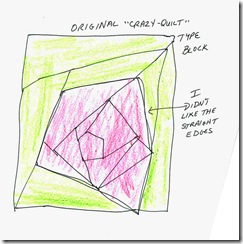
To add a wavy edge to the rose, do the following:
1) With the block right side up, lay a piece of “rose-colored” fabric right-side-down against the block, along one edge of the rose
2) Stitch the fabric down to the block along the straight edge of the rose
3) Flip the stitched-down fabric back and press
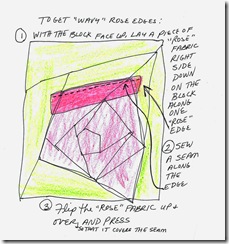
4) Trim the stitched-down fabric so that’s wavy.
5) Sew the next piece of rose-colored fabric down along the next edge, flip, and press
6) Continue to add pieces to each of the 5 sides of the rose
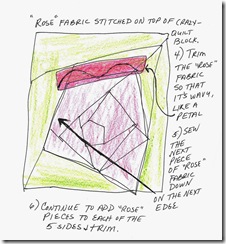
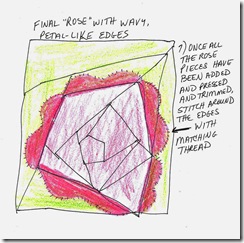
A couple of people asked this: how do you get the curved/wavy outside edges on the roses? Unfortunately, I didn’t take pics of the process as I went, so I’ve reconstructed the steps in (very primitive) drawings to try to illustrate the process. It’s harder to explain how I did it than to actually do it, btw.
As I mentioned in the previous post, I used a typical crazy-quilt type block. I started in the center with the pink or red fabric for the rose, then kept moving out until I switched to green and completed the block. At that point, I had a 5-sided “rose” that I wasn’t crazy about because the edges were straight:

To add a wavy edge to the rose, do the following:
1) With the block right side up, lay a piece of “rose-colored” fabric right-side-down against the block, along one edge of the rose
2) Stitch the fabric down to the block along the straight edge of the rose
3) Flip the stitched-down fabric back and press

4) Trim the stitched-down fabric so that’s wavy.
5) Sew the next piece of rose-colored fabric down along the next edge, flip, and press
6) Continue to add pieces to each of the 5 sides of the rose


Friday, August 12, 2011
Roses (Not) on My Table
A while back there was a discussion on the Quiltart list about using scraps to make quilts. I’m a compulsive scrap saver, and sometimes when I’m too nervous to cut into that gorgeous fabric I bought, or when I’m not really sure what kind of quilt I want to make, it’s easier for me to start playing around with stitching scraps together.
These blocks were made in crazy-quilt fashion. I initially moved right from the red & pink of the roses into the green, but the flowers looked too blocky. I ended up stitching another layer of pink or red to the edge of each flower, then flipping it open, trimming it into a curvy shape, and stitching down the edges. I like the softer, curvy edge of the flowers better than the original “crazy-quilt” block.

I quilted each block as I went, then put them together using Fiona’s Quilt as You Go (QAYG) tutorial. I love putting quilts together this way, because I don’t have to wrestle a large one under the needle of my small machine, but I’m still having some problems with the stitching. My walking foot a,nd feed dogs don’t really “grip” the multiple layers of fabric well and move them through the machine at an even rate, so any of the stitching that shows can look very uneven. I had a lot of this bad stitching showing on the back, and unfortunately it was white thread against a pink background, so I ended up painting the thread to match the fabric. You can still see the stitching, but you have to look more closely now :-)
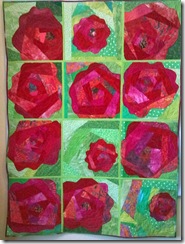
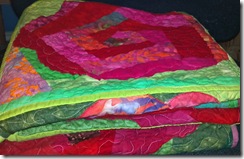
Not bad for a bunch of scraps, dont’cha think?
These blocks were made in crazy-quilt fashion. I initially moved right from the red & pink of the roses into the green, but the flowers looked too blocky. I ended up stitching another layer of pink or red to the edge of each flower, then flipping it open, trimming it into a curvy shape, and stitching down the edges. I like the softer, curvy edge of the flowers better than the original “crazy-quilt” block.

I quilted each block as I went, then put them together using Fiona’s Quilt as You Go (QAYG) tutorial. I love putting quilts together this way, because I don’t have to wrestle a large one under the needle of my small machine, but I’m still having some problems with the stitching. My walking foot a,nd feed dogs don’t really “grip” the multiple layers of fabric well and move them through the machine at an even rate, so any of the stitching that shows can look very uneven. I had a lot of this bad stitching showing on the back, and unfortunately it was white thread against a pink background, so I ended up painting the thread to match the fabric. You can still see the stitching, but you have to look more closely now :-)


Not bad for a bunch of scraps, dont’cha think?
Subscribe to:
Posts (Atom)
